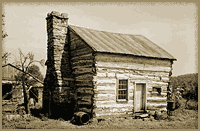







 |
 |
 |
 |
 |
| |
Spotlight: Harriet Tubman’s Birthplace
What kind of a place did Harriet Tubman live in when she was very young?

Harriet Tubman may have grown up in a house very much like this one.
|
Dr. John Seidel and Bonnie Ryan are working very hard to answer that question. They are archeologists who are looking for the remains of the home where Harriet Tubman was born. Archeologists are like detectives. They uncover and study objects from past cultures to learn more about the people who first used them.
The two want to find out more about Tubman’s early home because the area where it is located is under pressure by developers. People are building more homes in the area. The two felt that, if they didn’t act soon, they would lose a great opportunity to see into the past.
Ryan and Seidel both teach and research at Washington College in Chestertown, Maryland. The college is working together with the Maryland Historical Trust to explore Tubman's birthplace.
Tubman was born around 1820 on a “plantation” in Dorchester County owned by the Brodas (or Brodess) family. “Plantation” was a word people used then to refer to any farm, large or small. The Brodas farm was definitely small. Its land was not particularly good for farming, either. The home the Brodas family lived in was probably not very large. But no one knows for sure. Its remains have disappeared into the earth.
EXPLORING CLUES
Finding the remains of that house is very important to Seidel and Ryan. If they find what’s left of this “big” house, they will stand a better chance of finding the remains of any smaller outbuildings where slaves such as Tubman lived. Outbuildings, such as barns and sheds, would likely be located near the house where the master lived.
For the past two years, the two archeologists have studied old maps, county records, and other information to find the clues they needed in their search. During the summer of 2000, all that work began to pay off. That summer they started an archeological dig.

Washington College students sift through dirt hoping to unearth clues about Tubman’s birthplace.
|
THE PROCESS
But where to start? The property is very large. Looking for clues simply by walking over the land – even with instruments that help find buried objects – would take too much time.
Computers were the solution. The team used them to place several maps on top of each other digitally. When they did, they found a number of areas at the site that looked promising. They decided to concentrate on an area of 25 to 50 acres.
At this site, the team – as well as students from Washington College – roped off smaller areas to explore. Then they placed grids over the area, using stakes and twine so they could keep track of what they found and where they found it. As items were uncovered, the crew took photos of them. They placed a special marker beside the item to judge their size. Some of the items were then removed from the ground and brought to the archeology lab at Washington College. There, people took more pictures of the items, and recorded information about each piece.
What they found...
Read other spotlighted stories | Back to Living History Home
|
|
 |
 |
 |
|
 |
|










